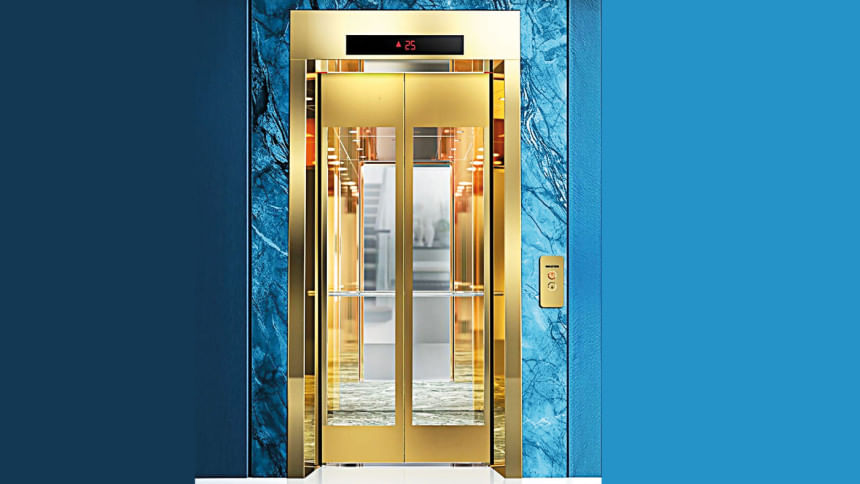Building the dream of a sustainable Bangladesh

Md. Jenan-Ul-Islam, Chief Business Officer, Walton Lift
The Daily Star (TDS): What key measures do you recommend to ensure the sustainability of construction materials during the building process, and which areas require the most urgent attention?
Md. Jenan-Ul-Islam (MJUI): When we talk about sustainability in the construction sector, it's important to understand that it's not something that can be "added on" at the end—it has to begin from the very first stage of planning a building. If we embed sustainability early, the impact stays with us throughout the entire lifecycle of the project.
Take lifts, for example. A sustainable lift is not only about saving electricity when it runs, but also about how it is designed, the materials used, and how it integrates with the entire building. For true efficiency, we must choose energy-efficient lift models, ensure that recyclable and durable materials are used, and carefully match the capacity and speed of the lift with the actual needs of the building. If the wrong lift is installed—too large or too small—it leads to either overconsumption or underutilisation of resources, both of which are wasteful.
Another critical point is system integration. Modern lifts should not work in isolation. They should be connected seamlessly to the building's smart systems, such as power management and Building Management Systems (BMS). This integration ensures that energy use is optimised in real time, and it also makes the building safer and more responsive.
If you ask me what areas require the most urgent attention, I would say three things: energy efficiency, recyclability of materials, and smart integration with buildings. These are the pillars that will make the biggest difference in the sustainability journey of construction materials.

TDS: What types of products does your company offer, and how do you ensure they are both fit for purpose and aligned with sustainability priorities?
MJUI: At Walton Lift, our philosophy goes beyond just selling a lift. We like to say that we offer a long-term, safe, reliable, and sustainable vertical mobility solution. To us, a lift is not just a machine that carries people up and down—it's a part of everyday life that has to be safe, efficient, and environmentally responsible.
Our product portfolio is diverse. We provide Passenger Lifts, Cargo Lifts, Hospital Lifts, and Home Lifts. Each category is designed keeping in mind international safety standards and energy efficiency benchmarks. For example, hospital lifts are made with special attention to smoothness and reliability, because in a medical environment, every second counts. Cargo lifts, on the other hand, are built with strength and durability, so they can carry heavy loads without consuming unnecessary power.
But where we truly stand out is in our commitment to lifecycle sustainability. This means that our responsibility does not end after installation. From maintenance to modernisation, we ensure that our lifts remain energy-efficient, safe, and up-to-date with technology. For older buildings, we also offer modernisation services—replacing outdated components with advanced, eco-friendly systems that extend the lift's life and drastically cut down on energy consumption. This not only saves money for our clients but also reduces the carbon footprint of the building.
In short, whether it's a high-rise apartment, a busy hospital, or a private residence, our lifts are designed to be fit for purpose, environmentally responsible, and future-ready.
Over the past few years, we have introduced several groundbreaking green technologies that make our lifts both smarter and more efficient.
One of our biggest achievements is the adoption of the gearless traction system. Compared to conventional systems, this technology saves between 30 to 40 percent of electricity. When you think about the number of lifts in a city like Dhaka, that saving becomes enormous—not just in cost, but in reduced energy demand for the entire country.
Another major advancement is our IoT-based Smart Control System. This system allows for real-time monitoring and optimisation of lift performance. It can detect problems before they become serious, ensure smooth operation, and provide building managers with valuable data to manage energy use more effectively.
We've also introduced the energy-regenerative drive technology, which is one of the most exciting innovations in this field. Essentially, when a lift goes down with a heavy load, it creates energy—our system captures that energy and sends it back to the building's grid, instead of wasting it. This way, the lift itself becomes a source of reusable energy.
Looking into the future, our plans are even more ambitious. We are working on solar-powered lift systems that can make buildings less dependent on the grid, AI-driven predictive maintenance that will use artificial intelligence to detect faults in advance, and electric battery-powered home lifts, which will make vertical movement in residences more accessible, especially in areas with unstable electricity supply.
Our vision is to create lifts that are not only energy-independent and user-friendly but also perfectly aligned with the urban needs of tomorrow.
TDS: What forms of policy reform or government support would help make sustainability efforts in the construction sector more effective and long-lasting?
MJUI: The government has a very important role to play in making sustainability a reality. Private companies like Walton can bring technology and innovation, but for large-scale adoption, we need policy support and public awareness.
Firstly, we recommend the introduction of green standards and certifications for energy-efficient lifts. This would encourage both developers and consumers to choose environmentally friendly solutions. Secondly, tax exemptions and incentives for companies adopting eco-friendly technologies would make it easier for the industry to scale up green innovations.
Equally important are public-private partnerships in areas such as research, training, and development. When industry expertise combines with government support, the results are long-lasting and impactful. Finally, awareness campaigns about the benefits of sustainable lifts could help create a stronger demand from the public, which in turn will push the market towards eco-friendly choices.
With these policy reforms, sustainability will no longer be an option—it will become the natural standard for the construction sector in Bangladesh.

 For all latest news, follow The Daily Star's Google News channel.
For all latest news, follow The Daily Star's Google News channel. 



Comments